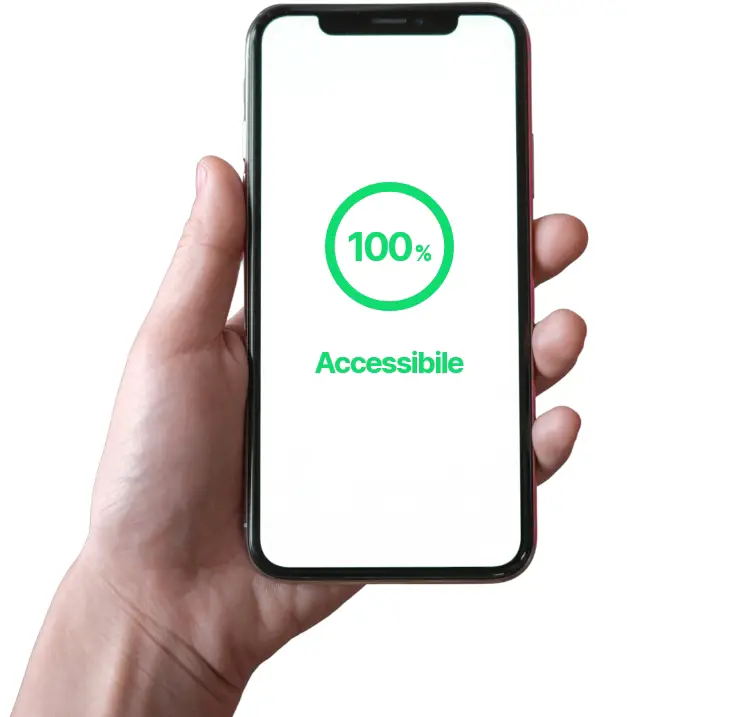
Have you ever wondered what it's like to navigate your project with your eyes covered? Can a user with disabilities perceive and understand all the content? Making a digital project accessible and free from digital architectural barriers means improving its content and functions to allow all users, including those with disabilities, to use it without any problems. For example, accessibility for blind or visually impaired people requires the support of the most common voice assistants, such as Cosimo for Windows, VoiceOver for iOS, TalkBack for Android. But let's take it step by step.
Should I comply my website?
In a nutshell, yes you should. Everyone should comply. Stanca Law defines criteria and that all companies have to respect.
Article 3, paragraph 1-bis of Law 4/2004 establishes three thresholds for the application of the accessibility law:
Article 3, paragraph 1-bis of Law 4/2004 establishes three thresholds for the application of the accessibility law:
- Public Administrations and private entities of public utility (e.g., public transportation companies) have been required to apply the appropriate accessibility conditions since 2004.
- Private entities with a turnover exceeding 500 million Euros per month must draft and publish their Accessibility Statement by November 5, 2022.
- All other private entities will have to comply with the Accessibility Act (EU directive 2019/882) starting from June 2025.
Which authority regulates digital accessibility?
Did you know...
The term "accessibility" has been around for over 30 years! “Disability Discrimination Act” put in evidence the issue of discrimination against citizens with disabilities in Australia in 1992. Tim Berners Lee, the inventor of the World Wide Web, immediately understood the importance of accessibility in the web context. In 1996, the first W3C newsletter was sent out, highlighting some best practices on accessibility. 1997 marked the foundation of the WAI (Web Accessibility Initiative), introducing the first standards and official documentation to help understand and implement web accessibility. It wasn't until 1999 that the WCAG 1.0 was introduced, and we had to wait until 2008 for the 2.0 upgrade. In 2016, the European Union aligned with the WCAG guidelines through the "Web Accessibility Directive" leading to the most recent international adaptation in 2018. Finally, we obtain AgID guide lines, that is WCAG 2.1, thanks to this latter international adaptation!
In Italy, the accessibility of websites and apps is monitored by AgID, the Agency for Digital Italy. This agency contributes to the spread of the use of information and communication technologies and promotes the transition of the digital towards accessibility. AgID requires the drafting and publication of the Accessibility Statement, which is a self-certification indicating the current accessibility status of a website or application. It provides a template that can assist in drafting the statement.
AgID's guidelines are based on international references outlined in WCAG 2.1 (Web Content Accessibility Guidelines) and the recommendations of W3C (World Wide Web Consortium) from June 5, 2018.
What does accessibility requirements mean?
Any digital service have to adhere to 4 accessibility principles, established by the WCAG 2.1, which is the set of guidelines that define criteria and technical specifications. Your websites or apps have to be:
Based on these 4 principles, the optimization of the project assumes different compliance statuses: compliant, partially compliant, non-compliant. Before analyzing the accessibility status, you need to appoint the company's Digital Transition Manager (RTD). Public Administrations have to provide the RTD's email within a Public Administration Index (IPA), which is a freely accessible database that allows communication with Public Administrations and Public Service Managers.
What are the main technical interventions?
It depends on the technology, language, features and the structure used.
The first things that we address mainly in our projects include:
The first things that we address mainly in our projects include:
- The “aria-label” attributes on interactive elements (like buttons, links, etc.), which inform assistive technologies about the purpose of that element.
- The “alt” tags (alternative text) on images, which describe the image and allow for a satisfying and comfortable navigation even for users with visual disabilities.
- Properly hierarchized title tags (H1, H2, H3, etc.) that provide a structured reading context.
- Complete keyboard navigation, enabling users to easily browse and interact with the website using the keyboard (e.g., using the “tab” key and the arrows).
- Adequate navigation time allowance; we don’t automatically reload content, giving users all the time they need to read and interact.
- Adaptability: our designs are responsive so they can adjust to various devices' needs (desktop, smartphone, tablet, etc.) and are compatible with the main operating systems (Microsoft, Apple, iOS, Android).
- Technological optimization to enhance content loading speed and reactivity, ensuring a comfortable use of both websites and apps.
How can I verify the accessibility of my website?
AgID doesn't provide a specific testing tool. However, they offer a self-assessment form that helps to determine the accessibility score of your website and/or app. You can find the self-assessment form here. We recommend filling it out with the assistance of webmasters and legal consultants. ti consigliamo di compilarlo con il supporto di webmaster e consulenti legali.
There are also online accessibility verification tools.
You can check the accessibility status and issues of your website using the free tool provided by AccessiWay. Just enter the address of the page you want to scan, click on 'Submit' and the tool will scan all the elements of the page showing you both the level of compliance (e.g., Non-Compliant, Semi-Compliant, Compliant) as well as problems you have to fix.
You can check the accessibility status and issues of your website using the free tool provided by AccessiWay. Just enter the address of the page you want to scan, click on 'Submit' and the tool will scan all the elements of the page showing you both the level of compliance (e.g., Non-Compliant, Semi-Compliant, Compliant) as well as problems you have to fix.
Google Lighthouse is another useful and free tool to scan your website. Open it with the Chrome browser, press F12 on the keyboard (or by right-clicking and selecting Inspect), choose Lighthouse in the menu, and select Accessibility among the "Category" options. Click on Analyze page load and once the scan is completed, Lighthouse will show you score and optimizations it has detected.

For mobile apps, Google offers Android Accessibility which allows you to record or take screenshots of screens where accessibility issues are detected. It also points out the exact nature of the problem and suggests a series of solutions (e.g. increasing font size, descriptions on icons, etc.)
iOs is a bit more complex as the app's use is "simulated" from a computer, for examples using the iOS Simulator which integrates the Xcode Accessibility Tool. However, the principle is the same as Android Accessibility.
We handle the whole optimization process, updating, and drafting of the Accessibility Statement in a few, simple steps:
iOs is a bit more complex as the app's use is "simulated" from a computer, for examples using the iOS Simulator which integrates the Xcode Accessibility Tool. However, the principle is the same as Android Accessibility.
What can we do for you?
We think inclusion is a fundamental value. We've decided to take this journey to support our clients and make their digital projects accessible.
We handle the whole optimization process, updating, and drafting of the Accessibility Statement in a few, simple steps:
So, to conclude, the topic of accessibility will take center stage in the coming years, both due to legal mandates both the moral duty in matters of inclusion and usability. The result of this journey is a comfortable user experience, the best calling card for your project.



